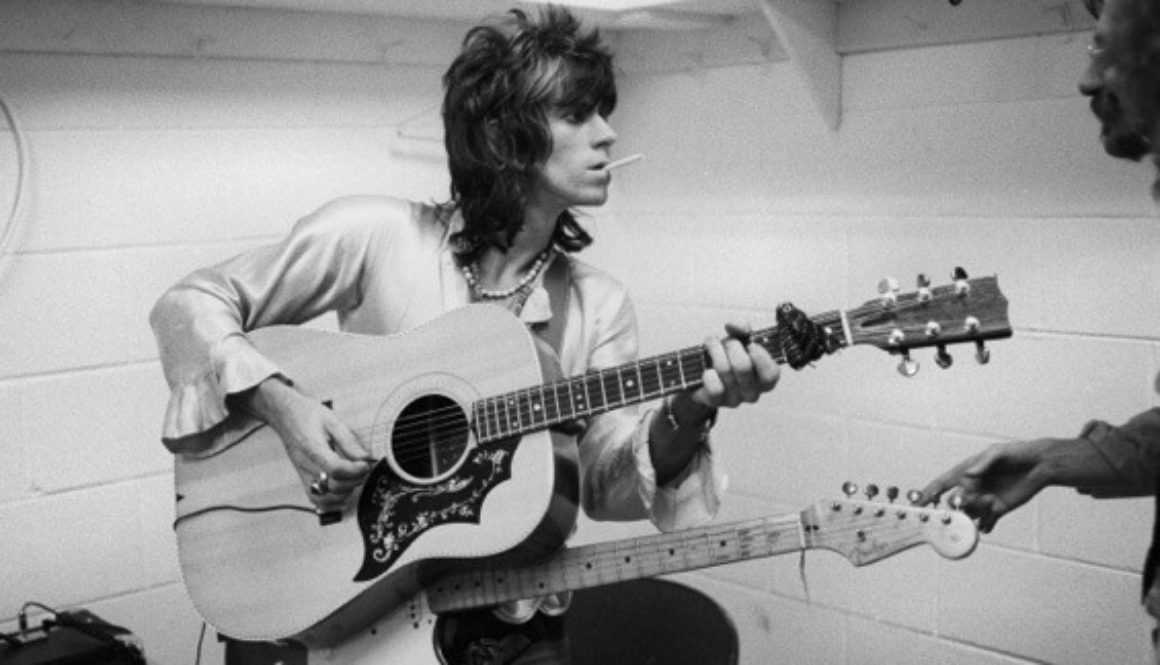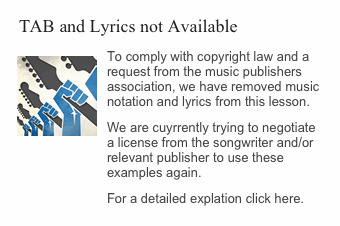Happy – The Rolling Stones

I learned a lot of Rolling Stones songs when I first took up playing guitar, which was good and bad. It was good because the songs were relatively easy to pick up (in terms of chords and rhythms) and that people liked to hear them. But somehow, even when I was certain I had an easy song like Honky Tonk Women down cold, it still didn’t sound quite “right.” I was missing something, including the clues that would help me figure out what I was missing.
But when I became aware of the concept of open and alternate tunings, things became much clearer. I imagine that my discovery of Keith Richards’ use of open G tuning was like the archaeologists of yore discovering the Rosetta Stone.
Let me explain. If you listen to Keith play rhythm, it sounds as if he’s always switching between a chord and a suspended four of that chord. But it also sounds a lot like the first part of a blues shuffle, when you add the sixth to the root (see our earlier lesson, Roll Over Beethoven). This is because he is adding both the fourth AND the sixth to the original chord. Let’s look at this with an A major chord:
It has a great sound to it, doesn’t it? Please notice that I gave this second chord two names. Yes, we could give it a lot more, but that would probably result in you coming up with a lot more names for me. Instead, let’s tune our guitars to open G tuning and let me show you something really wild. You can tell the fun stuff is just ahead because here’s the disclaimer:
These files are the author’s own work and represent his interpretation of this song. They are intended solely for private study, scholarship or research.
Coming Attractions
Open G tuning is when your guitar is tuned in such a way that when you strum it without fretting any strings (all “open” strings, get it?) you are playing a G major chord. To get from standard tuning to open G tuning, we’ll have to lower the 1st, 5th and 6th strings down one whole step:
(By the way, if you’re really interested in open tunings, check out something I wrote a while back, Look Ma, No Hands.)
Okay, have I taught you how to play an Am7 chord? It’s simply a normal Am chord, with the G string open:
Nothing to it, right? Let’s try it with our open G tuning:
If you looked at the notes involved, we could call this G6sus4. Or we could make our lives much easier by looking at it as a C chord with a G in the bass. This is written as “Cadd9/G.” If we don’t play the first or sixth strings (eliminating the D note) it is simply C/G.
One more thing I’d like you to do: play this without using your index finger. Use your middle finger on the B string and either your ring finger or pinky on the D string. Practice alternating between the open G and the C/G and listen to how you now have that chugging R&B rhythm sound no matter what tempo you’re playing at. Strum it slowly or at breakneck speeds and hear how it flows.
So, what have we learned? You may not know it yet, but you’ve learned a lot. Take a moment and ponder that we’re playing this as G (open strings) with either G6sus4 (which we’ll just call Gsus for now, okay?) or C/G. G, our root, is the open fifth string. So, if we barre all the strings at any fret, we’ll get a major chord whose root is the note on that fifth string. Are you with me?
That’s pretty cool. Now let’s add our fingers in the Am7 shape:
That’s really cool. Richards uses this with reckless abandon and now you can, too. Take something simple, like this line in Honky Tonk Women (and forgive me because I know the timing is off on this one…):
Even something as seemingly complex as the intro to Brown Sugar becomes simply a matter of knowing where the root of your chord is:
Our Feature Presentation:
But we’re here to play Happy, if for no other reason than it’s one of my favorite Rolling Stones songs. I really don’t know why Keith doesn’t sing more often… Do I need to tell you that, since there are three electric guitars playing rhythm on the original recording while this arrangement is for a single acoustic guitar, it’s going to sound somewhat different? Didn’t think so…
For the single guitar, Happy becomes an exercise in strumming. We’re going to do something a bit different than our normal lessons. I don’t want you to worry about chords. If you were to look at this song written out in terms of chord changes it would scare you silly. Instead we’re going to look at it as a series of rhythmic riffs. And guess what? We’ve only got to learn three of them!
Believe it or not, this is essentially just another two-chord song, just like the ones we learned at the start of the Easy Songs for Beginners series. The two chords are B and E. With our open G tuning, and our capo placed on the fourth fret, here are what these chords look like (along with our “sus” chords):
This probably makes you wonder why you don’t always play in open G, right? Some people do!
Let’s get strumming, shall we? Here’s the first riff, which is played as an intro and then again in the last section of the chorus:
After all this time I hope I don’t have to tell you to start slowly. The object is to get all the pieces in place. Once you know what you’re doing you can concentrate on doing it faster. The great thing, though, is by the time you do know what you’re doing, you’re already faster!
I start this arrangement on the last half of the fourth beat with a little flourish of two sixteenth notes. So, if you were counting this out it would be “one and two and three and four – – da da – – one and two and…” etc.
In riff 1 we start the measure with a downstroke on the first beat. We then play a downstroke and an upstroke on the second beat. These, as well as the sixteenth note flourish, are all done on the open strings.
On the third beat we barre the first four strings on the fifth fret and strum the notes individually in a continuous downstroke. You can use whatever finger you want to. For some reason I find this easiest to do with my ring finger. Catch the third and fourth strings, then the second, and then the first. It’s okay if you also play the fifth, since it’s a part of this chord. After striking the first string on this downstroke, release your barre (letting all the strings be open again) and play an upstroke, letting it ring for a beat and a half. Kudos to those who recognize that Keith, by playing a half beat ahead of the first beat of the measure, has created an anticipation.
That’s the opening riff. If you’re at all familiar with Happy, you will immediately recognize what you’re doing. You should feel pretty good about it. Work on getting this as smooth as possible. When you’re ready, we’ll move on to the riff that you play over the verses:
Once you have the second riff down, you have practically learned the whole song. Again, you start with the two sixteenth notes at the end of the proceeding measure, played in a quick down and up stroke. When it comes to strumming a complicated pattern like this I find it helpful to think in terms of half-beats. Use downstrokes on the beat, upstrokes on the half-beat (or off-beat).
On the first beat play the open strings with a downstroke. Follow this with another downstroke on the second beat while fretting the “sus” chord (the Am7 shape). Keep your fingers there for a downstroke on the third beat. Then release your fingers to get the open strings on an upstroke on the second half of the third beat. Put you fingers back on when you play the upstroke on the last half of the fourth beat. Yes, it’s another anticipation.
The second full measure of this riff is where “the downstroke on the beat and upstroke on the half beat” really comes in handy. On the second half of the first beat, we want to come up again, starting a series of up and downstrokes. Each of these upstrokes will be with the open strings, and each downstroke will have the “sus” chord. We end with an upstroke on the last half of the third beat, which rings for a moment, allowing us to catch a short breath before starting in on the sixteenth note flourish again.
We play this two-measure riff once during each line of the verse. Since there are four lines to a verse, we will play this four times. So take the time to get used to it now, especially when you see that riff 3 looks surprisingly familiar:
Riff 3 has the exact same rhythm as riff 2. The only difference is that we are playing it at the fifth fret instead of using the open strings. Use your index finger to barre the fifth fret as we did earlier in the lesson. If you strike the sixth string during your strumming of either riff 2 or riff 3, don’t worry about it. Since that note is part of the chord you’ll sound fine. Riff 3 is used during the first four measures of the chorus (and is played twice, since it’s also two measures long) before going back to riff 1, which closes the chorus and brings us back to the next verse.
Okay, let’s put them all together. This is a fairly quick song – the suggested bpm is 130. That’s what the MIDI file is set for. Also, the MIDI file has only the intro and then two verses instead of three.
In this transcription, I’ve tried to make the lines match the length of the particular riffs. Riffs 2 and 3 are each two measures (eight beats) long while riff 1 cycles through one measure at a time. I think if you listen to the MIDI you’ll be able to figure it out:
HAPPY
– Richards / Jagger
INTRO: Riff 1
Verse 1:
Riff 2
Chorus:
Riff 3
Riff1
Verse 2:
Riff 2
Chorus:
Riff 3
Riff1
Verse 3:
Riff 2
Chorus:
Riff 3
Riff 1
Repeat and fade on last part of chorus over riff 1
I hope you’ve enjoyed this lesson and playing this great song. Open G tuning is a lot of fun and, as you’ve learned, it doesn’t take a lot to make yourself sound pretty good with it. By the way, this is a great song to play on the twelve-string. All the ringing notes, especially in riff 1, overlap and just keep piling onto one another. It’s amazing to hear.
As always, please feel free to write in with any questions, comments, concerns or songs (and/or riffs and solos) you’d like to see discussed in future pieces. You can either drop off a note at one of the Guitar Forums or email me directly at [email protected].
Until next lesson…
Peace
Where Did The Guitar Tab Go?On February 11, 2010 we received a letter from lawyers representing the NMPA and the MPA instructing us to remove guitar tab and lyrics from this page. You can read more about their complaint here. Alternatively, you can still find this complete article with tab and lyrics archived here.








